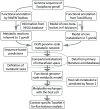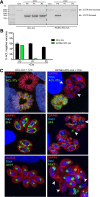Metabolic Needs and Capabilities of Toxoplasma gondii through Combined Computational and Experimental Analysis
- PMID: 26001086
- PMCID: PMC4441489
- DOI: 10.1371/journal.pcbi.1004261
Metabolic Needs and Capabilities of Toxoplasma gondii through Combined Computational and Experimental Analysis
Abstract
Toxoplasma gondii is a human pathogen prevalent worldwide that poses a challenging and unmet need for novel treatment of toxoplasmosis. Using a semi-automated reconstruction algorithm, we reconstructed a genome-scale metabolic model, ToxoNet1. The reconstruction process and flux-balance analysis of the model offer a systematic overview of the metabolic capabilities of this parasite. Using ToxoNet1 we have identified significant gaps in the current knowledge of Toxoplasma metabolic pathways and have clarified its minimal nutritional requirements for replication. By probing the model via metabolic tasks, we have further defined sets of alternative precursors necessary for parasite growth. Within a human host cell environment, ToxoNet1 predicts a minimal set of 53 enzyme-coding genes and 76 reactions to be essential for parasite replication. Double-gene-essentiality analysis identified 20 pairs of genes for which simultaneous deletion is deleterious. To validate several predictions of ToxoNet1 we have performed experimental analyses of cytosolic acetyl-CoA biosynthesis. ATP-citrate lyase and acetyl-CoA synthase were localised and their corresponding genes disrupted, establishing that each of these enzymes is dispensable for the growth of T. gondii, however together they make a synthetic lethal pair.
Conflict of interest statement
The authors have declared that no competing interests exist.
Figures





References
Publication types
MeSH terms
Substances
Grants and funding
LinkOut - more resources
Full Text Sources
Other Literature Sources

